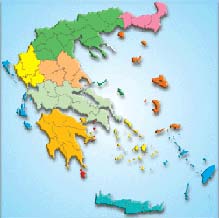
Please click on the map,
the region you want to visit |
|
|
|
|
| |
|
 |
Temple of Epicure Apollo |
|

Southwest of Andritsena, in 14 km, on a prestigious and wild mountainous scenery, at an altitude of 1130 meters, at the Mount Kotili, in a place that in antiquity was called Vasses (meaning a small valley between the rocks), is located the magnificent temple of Epicure Apollo, one of the largest temples of antiquity.
The Temple of Epicure Apollo was created by the architect of the Parthenon, Iktinos. It was constructed around 420 BC over an older temple by the people of Figaleia in honor of Apollo as a sign of gratitude for their salvation from famine. The name Epicure was given to Apollo around 650 BC, during the wars with Spartans.
It is a doric pavilion built of local limestone while the capitals of the nave were marbled, and some parts of the roof and of the ceiling and the carved decoration. It consists of vestibule, nave and a rear room, and it is oriented to north-south with a size of 14.48x38.24m. at the level of the surface.
 The Temple of Epicure Apollo is the first monument in Greece that was included by UNESCO (1986) in the list of the monuments of the World Heritage. The Temple of Epicure Apollo is the first monument in Greece that was included by UNESCO (1986) in the list of the monuments of the World Heritage. |
The temple is one of the finest surviving monuments of the classical antiquity. It is the best preserved temple after the temple of Hephaestus (Thissio) in Athens. It has a prominently in the history of the Greek architecture, combining with a unique way the archaising elements, which were determined by the local religious tradition, with the bold rejuvenating ideas of its creator.
The oblong ground plan of the surface (The raw of columns of the nave), and the number of the columns (6x15 instead of the normal for the era 6x13) and their layout (larger intercolumnium intervals on the short sides) are archaic features and refer to the great temple of Apollo at Delphi.
These elements, however, are "tied" in harmony with features of the classical Athenian architecture, such as the fineness of the columns, the small height of crepidoma and of the entablature and the spaciousness of the precursor and of the rear area. But the big innovation of the monument lies in the configuration of its interior.
In the nave (the main interior space of the ancient Greek temples, dedicated exclusively to the care of the statue of the god)there is the sense of a colonnade on three sides, like the Parthenon and the Temple of Hephaestus in Athens, but the columns of the long sides are not alone.
They are presented by the walls as thin transverse partitions, resulting in Ionic half columns with peculiar capitals and bases. In the narrow side of the nave, opposite the entrance, the single column had the first, in the history of architecture, Corinthian capital.
The colonnade supported an Ionic entablature (The part of the ancient buildings situated above the columns), with a relief frieze (An important architectural feature that adds elegance to the ceiling of the building. It is a decorative band that runs around the building. It is usually found on the outside of the building that along with the cornice and the architrave constitute the entablature),that ran inside the four sides of the nave.
The frieze of the temple is a true masterpiece in which the vitality and the expression of the types, and the mix of the plot of the scenes, have classified it amongst the best sculptors of antiquity decoration. It consisted of 23 plates with a length of 31 m, of which the western eleven depict a Centaur war and the eleven on the east an Amazon war.
Inside the temple there was a large (12 feet) bronze statue of Apollo.
Most of the slabs of the frieze are at the British Museum since 1814, while other parts are decorating the cases of the Louvre and Munich!
Nowadays maintenances of the temple are done by the scientists of Commission Epicure Apollo, which oversees the project and it has its base in Athens.
|







 |
| Photographs: Nikos Papadopoulos |
 |
Accommodation proposals, entertainment and shopping in Andritsena |
|
|
|